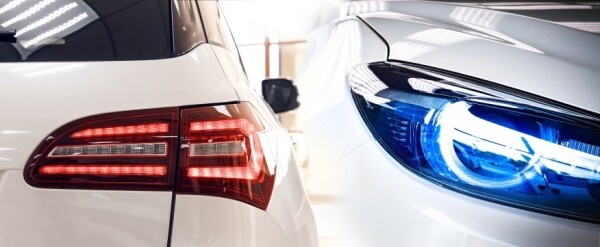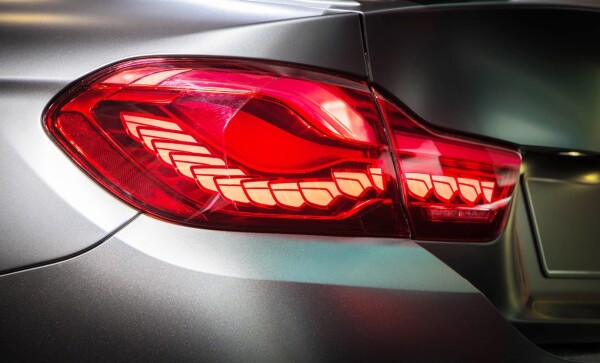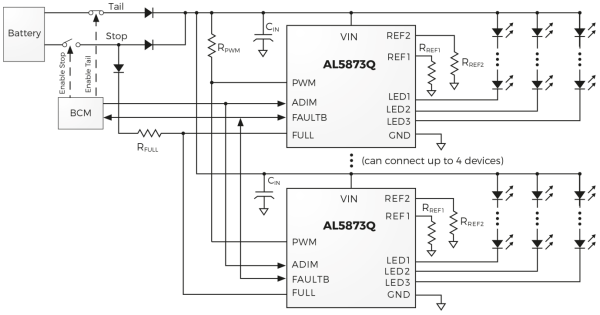New Advances in LED Control Systems for Automotive Exterior Lighting
Why Integrated Controller/Drivers are Making the Future Bright
By Allan Lin, LED Lighting Business Unit Director, Diodes Incorporated
Trends in Automotive Lighting Moving to LEDs
The automotive lighting market continues to grow strongly and is forecast by analyst Yolé to reach US$38.8 billion by 2024[1]. Over the past few years, LEDs have taken an increasing share of this market, and LED exterior lights have become a familiar sight on our roads.
Compared to incandescent bulbs, LEDs have a much longer life and save space, cost, and power, as well as offering new opportunities for complex and customized lighting systems. There is a trend towards more sophisticated control of LEDs rather than just switching them on or off; for example, to improve safety by including animation in turn signals, and varying the brightness of LEDs according to the changes of scenery.
As well as the LEDs themselves, a car also needs suitable electronic components to drive and control the LEDs. These must be reliable, compact, efficient, and able to provide special functions such as dimming and fault detection.
While discrete components have often been used for driving LEDs, there is a shift today to use integrated drivers. Let’s examine the requirements for these parts, and what they offer to automotive designers.

Figure 1: Automotive LED applications
Controlling LEDs
To generate the required light, the LED driver needs to apply a current reaching the minimum threshold voltage, called the “forward voltage”, between the LED’s anode and cathode to turn on the LED. This varies depending on the LED color, but is typically around 1.6V to 4V.
The brightness of the LED depends on the current provided, which means that the car’s lights can be dimmed with a suitable LED driver. There are two ways to do this: either by reducing the current, known as analog dimming, or by using Pulse Width Modulation (PWM) for digital dimming.
For automotive applications, an LED driver needs to be robust and able to operate over an extended ambient temperature range of -40°C to +105°C or 125°C. The device must be able to handle the widely varying voltage delivered from a typical commercial car’s 24V battery, the 12V battery of an internal combustion engine vehicle (ICEV), or the latest electric vehicle (EV) paired with a DC-DC converter and 12V auxiliary battery that powers EV accessories. Conformity with relevant electromagnetic compatibility (EMC) requirements is essential in the future wave of electric mobility.
By moving to more intelligent LED control using microcontrollers, another useful feature is a fault-detection function that can warn the driver of an LED failure and indicate its location, thus improving safety. With multiple LEDs in a typical car lamp, it can be difficult to detect when a single LED fails, because the other LEDs will continue to function. This can cause safety issues, as the lamp may not be able to meet the brightness required. Thus, an intelligent LED driver that can detect the fault is invaluable.

Figure 2: LED Rear Lights
Integrated LED Control in Practice
An example of an integrated LED driver is the AL5873Q from Diodes Incorporated. This is a three-channel linear LED driver with a wide input voltage range of 5V to 55V, which provides multiple functions that can simplify vehicle lighting designs.
Previous generation products required both a controller and a separate driver. Now, both functions are handled in a single component by the AL5873Q. By using a single device to drive the LEDs, which also minimizes the number of external components required, the design process is simplified and reliability can be improved.
In common with other automotive-compliant LED drivers from Diodes, the AL5873Q includes a built-in protection function. This uses the fault pin on the device to report the status of problems, for example, where an LED has failed.
Higher channel counts will be offered from single-channel and three-channel devices up to 36 channels and more by Diodes Incorporated’s next generation products. This means that many individual LEDs can be independently controlled by a single driver device, creating opportunities for pixel-led animation effects in automotive lights.
The AL5873Q supports both PWM and analog dimming, and can deliver up to 250mA per channel, or 750mA in total. The LED current levels can be controlled using two reference resistors, which means that the same LED emitters can be used both in rear lamp clusters and for tail and brake lights. This streamlines the design and means that the bill of materials (BOM) cost can be lowered substantially.
The lifetime of an LED can be substantially reduced if its junction temperature gets too high. To avoid this, the AL5873Q includes a temperature monitoring function, which reduces the LED current if the AL5873Q’s threshold temperature is exceeded. Overtemperature and LED string-open/-short protection monitoring are also provided, as well as input undervoltage lockout and fault indicator functions.
The AL5873Q is provided in the small-footprint TSSOP16 with exposed pad package, saving valuable space in light enclosures and offering a reliable, cost-effective solution that meets the rigorous AEC-Q100 Grade 1 automotive quality standard. As a linear LED driver, the AL5873Q does not require an external inductor, thereby reducing BOM costs and making EMI/EMC issues easy to solve.
A typical application is shown in Figure 3, with six channels of LEDs. The LED current level is controlled by the FULL pin: when this is pulled high, the LED current is set by the resistor connected to the REF2 pin; when the FULL pin is pulled low, the resistor connected to REF1 determines LED current. This means the same set of LEDs can function as both tail and brake lamps—with the controller enabling them to provide the two different brightness levels required for normal tail lamp operation and for stopping/braking.

Figure 3: Typical automotive LED application
Digital dimming is controlled with the PWM pin, with the LED current and brightness adjusted according to the PWM signal’s duty cycle. If analog dimming is preferred, the LED current can be linearly adjusted from 0 to 100% by varying the voltage at the ADIM pin from 0.3V to 1.5V.
Another power-saving function offered is the sleep or standby mode. If the PWM pin is pulled to the ground with no signal present for longer than 7ms, the AL5873Q goes into low standby current mode (drawing less than 250μA). For longer than 25ms, the AL5873Q goes into an ultra-low quiescent current mode (drawing less than 1μA), thus reducing overall power consumption.
Conclusion
Looking ahead, the future is bright for LEDs in the automotive sector. For starters, as electric vehicles replace existing petrol and diesel models, electronic power consumption and electrical motor conversion efficiency will increasingly become more important. As mileage range is a key selling point for electric cars, minimizing the electronic power used by all electronic accessories, including lighting, will be one of the major factors to prolong battery life when the car is in idle or driving—hence increasing the miles that can be covered between charging stops.
Car makers will also be looking for new ways to differentiate their products, and LED lighting can give them a highly visible advantage with customized form factors and animation. Additionally, vehicles are becoming highly sophisticated “computers on wheels”, which means designers are looking for LED drivers that allow for cars to communicate and report a problem.
As these requirements evolve, integrated and intelligent LED controller/drivers from vendors, such as Diodes Incorporated, will enable designers to get the best usage and features from LEDs, meeting customers’ needs wherever they go.
[1] Source: http://www.yole.fr/AFLS_Lighting_to_ADAS.aspx
First published by Power Systems Design (www.powersystemsdesign.com) July 30th, 2021